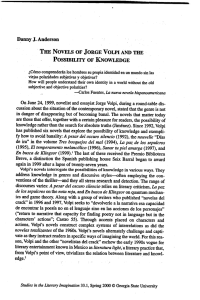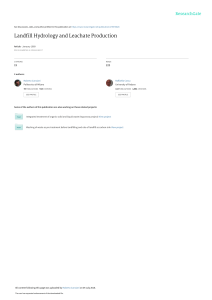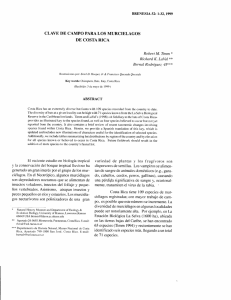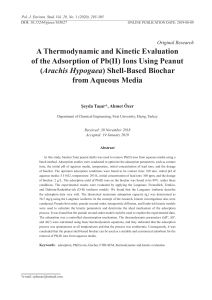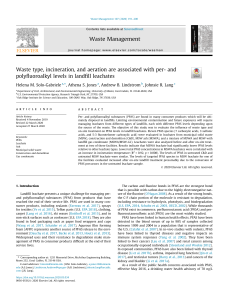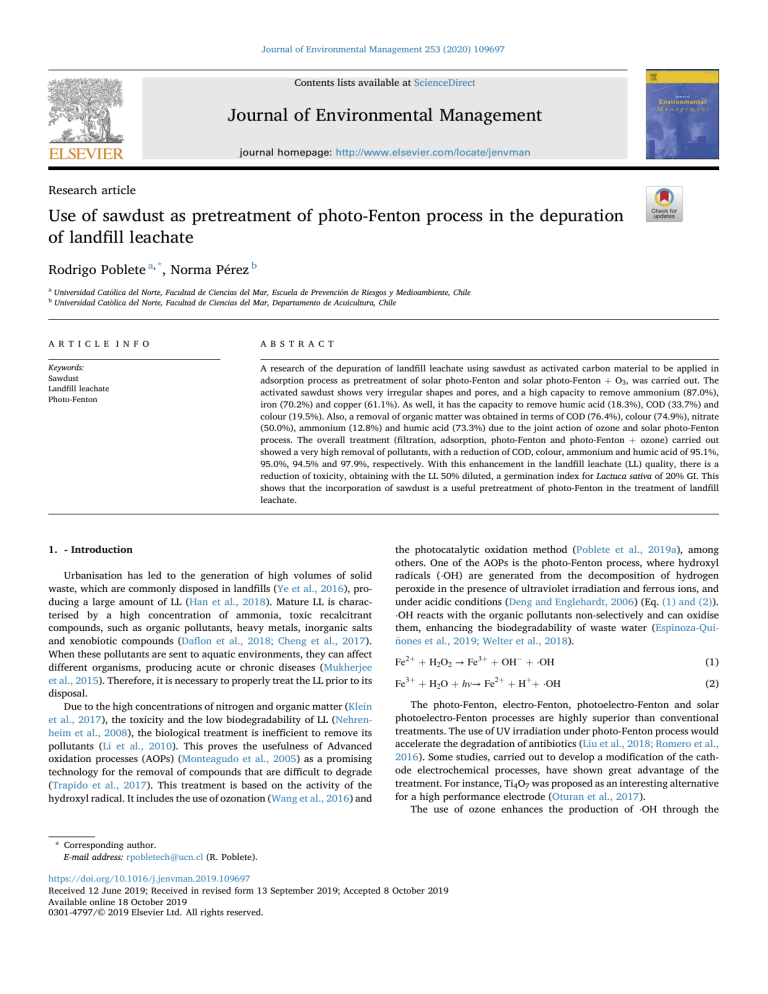
Journal of Environmental Management 253 (2020) 109697 Contents lists available at ScienceDirect Journal of Environmental Management journal homepage: http://www.elsevier.com/locate/jenvman Research article Use of sawdust as pretreatment of photo-Fenton process in the depuration of landfill leachate Rodrigo Poblete a, *, Norma P� erez b a b Universidad Cat� olica del Norte, Facultad de Ciencias del Mar, Escuela de Prevenci� on de Riesgos y Medioambiente, Chile Universidad Católica del Norte, Facultad de Ciencias del Mar, Departamento de Acuicultura, Chile A R T I C L E I N F O A B S T R A C T Keywords: Sawdust Landfill leachate Photo-Fenton A research of the depuration of landfill leachate using sawdust as activated carbon material to be applied in adsorption process as pretreatment of solar photo-Fenton and solar photo-Fenton þ O3, was carried out. The activated sawdust shows very irregular shapes and pores, and a high capacity to remove ammonium (87.0%), iron (70.2%) and copper (61.1%). As well, it has the capacity to remove humic acid (18.3%), COD (33.7%) and colour (19.5%). Also, a removal of organic matter was obtained in terms of COD (76.4%), colour (74.9%), nitrate (50.0%), ammonium (12.8%) and humic acid (73.3%) due to the joint action of ozone and solar photo-Fenton process. The overall treatment (filtration, adsorption, photo-Fenton and photo-Fenton þ ozone) carried out showed a very high removal of pollutants, with a reduction of COD, colour, ammonium and humic acid of 95.1%, 95.0%, 94.5% and 97.9%, respectively. With this enhancement in the landfill leachate (LL) quality, there is a reduction of toxicity, obtaining with the LL 50% diluted, a germination index for Lactuca sativa of 20% GI. This shows that the incorporation of sawdust is a useful pretreatment of photo-Fenton in the treatment of landfill leachate. 1. - Introduction Urbanisation has led to the generation of high volumes of solid waste, which are commonly disposed in landfills (Ye et al., 2016), pro­ ducing a large amount of LL (Han et al., 2018). Mature LL is charac­ terised by a high concentration of ammonia, toxic recalcitrant compounds, such as organic pollutants, heavy metals, inorganic salts and xenobiotic compounds (Daflon et al., 2018; Cheng et al., 2017). When these pollutants are sent to aquatic environments, they can affect different organisms, producing acute or chronic diseases (Mukherjee et al., 2015). Therefore, it is necessary to properly treat the LL prior to its disposal. Due to the high concentrations of nitrogen and organic matter (Klein et al., 2017), the toxicity and the low biodegradability of LL (Nehren­ heim et al., 2008), the biological treatment is inefficient to remove its pollutants (Li et al., 2010). This proves the usefulness of Advanced oxidation processes (AOPs) (Monteagudo et al., 2005) as a promising technology for the removal of compounds that are difficult to degrade (Trapido et al., 2017). This treatment is based on the activity of the hydroxyl radical. It includes the use of ozonation (Wang et al., 2016) and the photocatalytic oxidation method (Poblete et al., 2019a), among others. One of the AOPs is the photo-Fenton process, where hydroxyl radicals (⋅OH) are generated from the decomposition of hydrogen peroxide in the presence of ultraviolet irradiation and ferrous ions, and under acidic conditions (Deng and Englehardt, 2006) (Eq. (1) and (2)). ⋅OH reacts with the organic pollutants non-selectively and can oxidise them, enhancing the biodegradability of waste water (Espinoza-Qui­ ~ ones et al., 2019; Welter et al., 2018). n Fe2þ þ H2O2 → Fe3þ þ OH þ ⋅OH (1) Fe3þ þ H2O þ hv→ Fe2þ þ Hþþ ⋅OH (2) The photo-Fenton, electro-Fenton, photoelectro-Fenton and solar photoelectro-Fenton processes are highly superior than conventional treatments. The use of UV irradiation under photo-Fenton process would accelerate the degradation of antibiotics (Liu et al., 2018; Romero et al., 2016). Some studies, carried out to develop a modification of the cath­ ode electrochemical processes, have shown great advantage of the treatment. For instance, Ti4O7 was proposed as an interesting alternative for a high performance electrode (Oturan et al., 2017). The use of ozone enhances the production of ⋅OH through the * Corresponding author. E-mail address: [email protected] (R. Poblete). https://doi.org/10.1016/j.jenvman.2019.109697 Received 12 June 2019; Received in revised form 13 September 2019; Accepted 8 October 2019 Available online 18 October 2019 0301-4797/© 2019 Elsevier Ltd. All rights reserved. R. Poblete and N. P�erez Journal of Environmental Management 253 (2020) 109697 photoreduction of Fe3þ as shown in Eq. (3) and as established by Chandrasekara Pillai et al. (2009), allowing the enhancement of the organic matter removal (Oloibiri et al., 2017) Fe3þ þ O3 þ H2O → (FeO)2þ þ Hþþ ⋅OH þ O2 characteristics of the untreated LL are shown in Table 1, where a high amount of COD and colour can be observed. (3) 2.1. - Adsorption process and solar photo-Fenton process The combined action of the O3 and the photo-Fenton processes en­ hances the elimination of organic pollutants compared to other AOPs (Chandrasekara Pillai et al., 2009) in terms of colour and COD removal. This removal is attributed to parallel pathways (Eqs. (2) and (3)) through which abundant �OH is produced and to the incorporation of O3 that improves the efficient use of energy associated with electrical en­ ergy per order (Asaithambi et al., 2017). Also, When Fe2þ is added in the solution, it produces ozone decomposition to give additional ⋅OH radical due through the formation of O3 anions (Eqs. (4) and (5)) (Legube and Karpel Vel Leitner, 1999). Fe2þþO3 → Fe3þ þ O3 (4) O3 þ Hþ →HO3 → ⋅OH þ O2 (5) Before being subject to the adsorption and photo-Fenton processes, LL samples were pre-filtered using a 5 μm filter. Adsorption was per­ formed using SD. The SD was washed with boiled distilled water to eliminate impurities and dust. Then, it was oven-dried at 105 � C for 24 h. Afterwards, the SD was activated with H3PO4 and calcined at 350 � C for 3 h at an impregnation ratio of 1:1, according to the methodology used by our research group in Poblete et al. (2017). The pH of the activated SD was 1.5 and the ash content, 2.09%. Fig. 1 shows photographs of the SD after the activation process. The samples were photographed using a scanning electron micro­ scope (Hitachi SU3500). The samples were mounted on a structure and coated with gold in a JEOL JFC-100 evaporator. The activated SD shows very irregular shapes and pores. For the adsorption experiments, 35 L of LL were stirred in a sus­ pension of SD at a load of 1 g/L for 2 h, using a centrifugal pump (370 W of power) that produced a turbulent recirculation of 40 L/min. The adsorption percentage of heavy metals in the LL was calculated using Eq. (6): In order to prevent environmental impacts from LL, it is necessary to use a combination of treatments. The joint action of the adsorption process and the photo- Fenton process is effective in complex waste­ water. Also, it was established that the application of a pretreatment enhances the performance of the photo-Fenton process (Shon et al., 2007). The adsorption technique is considered an efficient process due to various advantages associated with low cost, simplicity, design flex­ ibility and insensitivity to toxic pollutants (Shakoor and Nasar, 2018; Boonyaroj et al., 2012). The use of cheap and effective adsorbent materials like wastes, has gained the attention of researchers due to their abundance and low-cost (Georgin et al., 2018; Mohammad-pajooh et al., 2018; Chieng et al., 2017; Aljeboree et al., 2014). The application of sawdust (SD) in ground allows controlling the diffusion of LL in landfill soils (Keramatikerman et al., 2017). The activated carbon obtained from SD has a high potential to remove heavy metals specially Cr (VI) from industrial water effluents. SD is generated in high amounts all over the world (Gao et al., 2018; Chin et al., 2011) and it is produced by cutting, drilling, grinding, sanding or pulverizing wood using a tool. SD is an available wood waste produced in the carpentry and furniture industry (Dolatabadi et al., 2018), with high carbon content (Kazmierczak-Razna et al., 2015). Sawdust is comprised of electron rich functional groups, which offer active sites for heavy metal traps. The acid or alkali activation of these sites enhances their adsorption efficiency (Khalid et al., 2018). Thus, sawdust is considered an auspicious adsorbent for organic pollutant removal (Cansado et al., 2018; Zhou et al., 2014). The use of SD acti­ vated at 600 � C and impregnated with ZnCl2 was studied, observing a lower energy consumption and a higher adsorption capacity of pollut­ ants in aqueous medium (Nayak et al., 2017). However, the use of SD in the adsorption process of LL needs to be studied and evidence should be gathered to support its efficacy. The aim of this research has been to study the adsorption process, using SD as a pretreatment for the solar photo-Fenton process of LL in a strategy to enhance the quality of this wastewater and reduce its toxicity. This considers the potential capacity of the SD as an adsorbent material being able to retain pollutants that reduce the performance of the photocatalytic process. Adsorptionð%Þ ¼ C0 Cf C0 *100 (6) where, C0 and Cf are the initial and final concentrations of pollutants in LL (mg/L), respectively. The adsorption capacity of the SD (q, mg/g) was determined using the mass balance equation for the adsorbent: q¼ C0 Ce m *V (7) where, Ce is the pollutant concentration in the LL under equilibrium conditions, V is the LL volume in the adsorption process (L) and m is the mass of the adsorbent (g). After the adsorption process, the LL was subject to a solar photoFenton process and a solar photo-Fenton/O3 process. The solar photo­ reactor used in the photocatalytic experiments was a compound para­ bolic collector (CPC) pilot plant, with a total volume (Vt) of 25 L and an irradiated volume (Vt) of 20 L (see Fig. 2). This photoreactor is an adequate choice for solar photochemical applications, being able to receive and use direct and diffuse solar radiation (De la Cruz et al., 2013). The CPC photoreactor is constituted of five 135 cm long, 50 mm external diameter, a 1.4 mm thick borosilicate tubes (connected in se­ ries) mounted on the focal axis of parabolic trough reflectors, made from highly anodised aluminium. The irradiated area was 5 m2. The LL was pushed through the tubes by a centrifugal pump (0.5 HP), with a flow of 25 L/min. In the lower outer area of the CPC photoreactor there was a valve, where samples were taken and some parameters were measured as well. Solar ultraviolet radiation (UV) was determined using a UV Table 1 Characteristics of LL. 2. - Materials and methods Sawdust obtained from carpentry stores in Coquimbo, Chile was evaluated for its use as an activated carbon to be applied in an adsorbent process (pretreatment of a solar photo-Fenton process) for the depu­ ration of LL. The LL samples used were sampled from a Chilean landfill placed in El Panul, where domestic waste is handled. The main 2 Parameter Value COD (mg/L) pH Ammonium (mg/L) Total Iron (mg/L) Colour (PCU) ABS254 Nitrate (mg/L) Copper (mg/L) 11,950 8.9 4628.5 55.8 18,600 14.9 34.5 375.0 R. Poblete and N. P�erez Journal of Environmental Management 253 (2020) 109697 Fig. 1. Photograph of the SD after the activation process. HI83099. Humic acid concentration, that when high is an indicator of old LL and it is predominated by recalcitrant organic compounds (Kang et al., 2002), was determined using a spectrophotometer at 254 nm (Optizen Pop). Nitrate and ammonium concentrations were measured using cadmium reduction and Nessler methods (HACH), respectively. The COD concentration in LL was measured with the colorimetric method, according to EPA 410.4. Total copper was determined using the Bicichoninate acid Method (HI-93702-01). Ozone concentration in LL was determined with colorimetric method (Hanna Instrument, HI 83099) and chloride concentration was measured using ionic chroma­ tography, according to EPA 300.1. Iron was determined according to the EPA phenantroline method 315B. The ash content was measured in a muffle furnace (575 � C), according to the method described by Sluiter et al. (2004). 2.3. - Toxicity analysis Fig. 2. Schematic diagram of solar photoreactor CPC. The phytotoxicity of the different concentrations of LL was evaluated using raw LL and LL under different treatments carried out using Lactuca sativa seeds, according to the method described by Bowers et al. (1997). Phytotoxicity is evaluated by conducting germination and root growth tests. For these experiments, filter papers dampened with 5 mL of LL were placed in a Petri dish. The dilutions corresponded to 100%, 50%, 30%, 10%, 3% and 1% of concentrated LL measured throughout the different treatments. The assays were carried out in triplicated. After that, 10 seeds of L. sativa were placed on the Petri dish and left in the dark at 22 � C for 7 days. Three replicates were performed for each dilution. The germinated seeds were determined and the length of their roots was measured. Then, this was compared to the germination ob­ tained with clean water (control). Considering the length of their roots and the amount of germinated seeds, the germination index (GI) was calculated according to the method proposed by Tam and Tiquia (1994), using Eq. (8): pyranometer (KIPP&ZONEN, Model CUV 5) mounted on a metallic platform, tilted 30� (the same as the CPC reactor and the latitude of Coquimbo, where the solar experiments were performed). Solar photo-Fenton runs were carried out at a pH of 3 and the re­ agents used were H2O2 and FeSO4 in concentrations of 0.67 g/L and 0.3 g/L, respectively. Since H2O2 is consumed along the process, it was replaced at each hour to maintain the required concentration. The run lasted 12 h. The reagent concentrations and the treatment time were selected considering the previous results achieved by our research group (Poblete et al., 2019a), where fish scales were used as adsorbent mate­ rial and the solar photo-Fenton process was used in the treatment of LL. In all the experiments, the samples were taken in triplicated. The next day, a solar photo-Fenton/O3 process was carried out. For that, the same CPC photoreactor and reagent concentration were used. The addition of ozone into the LL was done by applying bubbles, using an ozone generator (Netech CH-KTB 3 G, 3 gO3/h of flow mass, 100 W of power). Ozone was added continuously through the upper opening of the CPC photoreactor, as shown in Fig. 2. GI ¼ G L * *100 Go L0 (8) where, G and L are the germination and root growth of the seeds in LL, respectively. G0 and L0 are the germination and root growth of the seed in the control, respectively. 2.2. - Analytical methods and measurements To determine the removal of pollutants during these treatments, colour, total solids, humic acid, COD, pH and concentration of chloride, nitrate, ammonium, iron, copper and ozone in LL were measured. LL colour was measured using the colorimetric platinum cobalt method in Platinum Cobalt Units (PCU; APHA, 1999), with a photometer Hanna 2.4. - Energy analysis AOPs consume electrical energy and this is one of the main opera­ tional cost of the process caused by the functioning of the related 3 R. Poblete and N. P�erez Journal of Environmental Management 253 (2020) 109697 equipment. In this context, it is useful to determine the electrical energy per order (EE/O) of the process and knowing the simple figures-of-merit, based on electric energy consumed, can be very informative. EE/O (kW⋅h/m3) is the electrical energy necessary to reduce the concentration of a pollutant by 1 order of magnitude in 1000 L of contaminated water. EE/O can be calculated using Eq. (9). P*t*1000 � � V*60*lg CC0f (9) where, EE/O is the electrical energy per order (kW⋅h/m3), P is the electrical power input required in the process (kW), t is the treatment time (min), V is the volume of LL treated (L) and, C0 and Cf are the initial and final concentrations of organic matter in the LL (mg/L), respec­ tively. Then, the specific energy consumption (SEC) levels for the pro­ cesses applied were calculated using Eq. (10): P P�t � SEC ¼ (10) C0 Cf �V 3. - Results and discussion 3.1. Removal of pollutants After carrying out the filtration, adsorption, photo-Fenton and photo-Fenton þ O3 processes, an evolution of the parameter studied in LL was observed, as well as a very high depuration level through it. When a filtration process was applied, a removal of 14.5%, 49.2%, 22.8%, 19.8% and 1.5% of colour, nitrate, ABS254, COD and ammonium, respectively (See Fig. 3), was obtained. These specific removal levels are not very significant. However, they allow enhancing the performance of the photo-Fenton processes because pollutants that negatively affect their efficiency are removed (Miralles-Cuevas et al., 2017). They pro­ duce a scattering effect in the ultraviolet penetration into the photo­ reactor (Poblete et al., 2019a). Silva et al. (2017) reported similar observations related to the use of a pretreatment and the subsequent enhancement in the performance of the photo-Fenton process. Consideration should be taken in regard to the fact that the UV absorbing property of the substances that quench the UV in LL treat­ ments, significantly reduces the efficiency of ultraviolet irradiation disinfection, which represents an emerging difficulty in wastewater treatment (Deng et al., 2018). Therefore, the removal of UV quenching using SD helps to reduce this problem. Color (PCU), Ammonium and COD (mg/L) 25000 40 Color Colour 35 COD 20000 Ammonium 30 ABS 254 Nitrate 15000 25 20 10000 15 10 5000 5 0 Raw Filt ADS PF PF+O3 Absorbance (254 nm) and Nitrate (mg/L) EE ¼ 0 Fig. 4 shows an evolution in the concentration of ammonium, iron and copper in LL, specially due to the adsorption process, going from 4558.2 mg/L to 592.4 mg/L, 350 mg/L to 136 mg/L and from 47 mg/L to 14 mg/L of ammonium, copper and iron, respectively, obtaining re­ movals of 87%, 61.1% and 70.2%, respectively. These results are based on the capacity of the SD to remove heavy metals from wastewaters (Rafatullah et al., 2009) thanks to its ligno­ cellulosic constituent (Nayak et al., 2017). The thermochemical acti­ vation significantly modifies the texture and porosity of the activated carbons (Nayak et al., 2017). This lignocellulosic waste, coming from the forestry industry, has emerged as a cheaper alternative to produce high quality activated carbons due to its favourable structural charac­ teristics and because of the large amount available, which it is mostly not used (Subbaiah et al., 2009). It was theorised that the ion exchange mechanism, happening be­ tween the hydrogen from cellulose molecules and adsorbing metal ions (like Ca-atoms) present in the adsorbent structure, can be exchanged with heavy metal ions (Bo�zi�c et al., 2013). The adsorption capacity of SD, calculated using Eq. (7), was 1982.3 mg/g, 16.5 mg/g and 107.0 mg/g for ammonium, iron and copper, respectively. The adsorption capacity for copper was higher than the one reported by Rafatullah et al. (2009), who obtained an adsorption capacity of 32.05 mg/g. The results of ammonium adsorption are in agreement with those obtained by (Rambabu et al., 2013), who also stated that the ammonium adsorption capacity depends on the acid–basic interactions between the ammonium ion and the surface functional groups of the adsorbents, as well as on the porous structure of activated carbon. A removal of humic acid (ABS254), COD and colour from LL was also observed after applying adsorption in SD, obtaining a reduction of 18.3%, 33.7% and 19.5%, respectively. These results are in agreement with those reported by Gallo-Cordova et al. (2017), who also observed a reduction of COD using SD. Humic acid is a typical and complex con­ stituent of LL (Li et al., 2019) and its removal allows improving the biodegradability of the LL, as stated in a previous work made by our research group (Poblete et al., 2019a). As shown in Fig. 3, the removal of COD, using the photo-Fenton process, was 60.6%. This result was higher than the one obtained by (Welter et al., 2018), who got a removal of 53% and 44% using fer­ rioxalate and ferricitrate treatments as organic ligands, respectively. The application of the photo-Fenton process using solar radiation in a CPC photoreactor enhances the production of �OH radicals, which are able to degrade most of the recalcitrant organic compounds present in LL, 0 Treatment Fig. 3. Evolution of the parameters in the landfill leachate subject to different treatments. Error bars represent the standard deviation of the results (n ¼ 3). 4 R. Poblete and N. P�erez Journal of Environmental Management 253 (2020) 109697 400 Copper Iron 5000 Ammonium 4500 4000 300 3500 250 3000 200 2500 2000 150 1500 100 Ammonium (mg/L) Copper and Iron (mg/L) 350 1000 50 500 0 Raw Filt ADS PF PF+O3 0 Treatment Fig. 4. Concentration of Copper and iron (mg/L) along different treatments. Error bars represent the standard deviation of the results (n ¼ 3). turning them into simpler and easily biodegradable organic compounds (Silva et al., 2017). A removal of COD, colour, nitrate, ammonium and humic acid was evinced when ozone was added to the photo-Fenton process, obtaining a reduction of 76.4%, 74.9%, 50.0%, 47.0% and 73.3%, respectively (see Fig. 3). This high pollutant removal is the result of the interaction be­ tween these processes (ozone and photo-Fenton), which allows a high organic matter oxidation due to the enhancement in the formation of ⋅OH. This latter is produced from the interaction between H2O2 and ozone (see Eq. (11)), that also consumes this reagent and forms �n et al., 2016). hydroxyperoxyl radical (Guzma One of the oxidation routes uses the photo-oxidation of ammonia and ammonium to produce NO2 , NO3 and nitrogen gas (Zhu et al., 2005). The other route considers the photo-reduction of NO3 to form N2 or NO2 (Krasae and Wantala, 2016). Similar observations were done by Dwyer et al. (2008), who obtained a high removal of these compounds using AOPs. The adsorption process, due to the action of SD, can enhance the performance of the photocatalytic process, as established in a previous research made by our research group (Poblete et al., 2019a). This because, under this treatment, some pollutants like UV-quenching sub­ stances were removed from the LL. These substances obstruct the ul­ traviolet transmittance required for the photocatalytic reaction (Deng et al., 2018) and also allow the removal of colour and heavy metals (Aguayo-Villarreal et al., 2017), improving the oxidation process. (11) O3 þ H2O2 → HO2⋅þ ⋅OH þ O2 Moreover, there is a high removal of the measured nitrogenous compound, nitrate and ammonium due to the photo-Fenton and the photo-Fenton þ O3 processes. The removal of these compounds during this process is a consequence of the high production of ⋅OH caused by the oxidation process (Lim et al., 2019). Control 140 Raw 3.2. Evolution of the toxicity Fig. 5 shows the Germination Index of L. sativa subject to different Filt ADS PF PF+O3 120 GI (%) 100 80 60 40 20 0 1 3 10 30 50 100 LL concentration (%) Fig. 5. Germination index (GI %) of L. sativa with different concentrations of LL (raw and treated), using filtration, adsorption, photo-Fenton and photo-Fenton þ O3 processes. Error bars represent the standard deviation of the results (n ¼ 3). 5 R. Poblete and N. P�erez Journal of Environmental Management 253 (2020) 109697 concentrations of raw and treated LL (filtration, adsorption on SD, photo-Fenton and photo-Fenton þ ozone). As explained before, this parameter takes into consideration the germination percentage and the root elongation of the seeds. The results are compared with those ob­ tained for the seed wetted with control water. On one hand, the elongation of the plant is a sensitive parameter, useful to assess the toxicity of the water (Priac et al., 2017) and on the other, the germination of the L. sativa assay provides information about the effects of low concentrated toxic compounds (Charles et al., 2011). The GI, determined using Eq. (8), was low in the LL subject to filtration only. However, a higher GI was observed after adsorption, photo-Fenton and photo-Fenton þ ozone processes and even a high concentration of LL was shown after the photo-Fenton þ ozone process. As shown in Fig. 5, the GI for the photo-Fenton þ O3 process was higher than the control when concentrations of the treated LL were 1% and 3%, obtaining a GI of 149.9% and 119.1%, respectively. The reason for this behaviour may be that, at this concentration, the treated LL can provide nutrients, which are beneficial elements to activate the enzyme activity of the seeds, promoting their germination and growth (Li et al., 2017). In the case of the filtration process, GI was observed just when the concentration of LL was 4% and 1%. After the adsorption on SD, a GI of 30% was observed. Then, after the photo-Fenton and the photo-Fenton þ O3 processes, the GI was 50%, being higher in this latter. These results were better than those obtained in our previous study, where we used fish scales in the adsorption process and no GI was observed when the concentration of LL was 10% (Poblete et al., 2019b). The photo-Fenton process is able to degrade the high organic load present in the LL, allowing to reduce the toxicity of this water (Welter et al., 2018; Silva et al., 2015). Also, considering that copper is a toxic and non-biodegradable metal (WHO, 2010), the removal of it helps to reduce the toxicity of LL, justifying the results obtained in the germi­ nation index test. When the LL subject to photo-Fenton þ O3 process was in concentrations of 3% and 1%, the GI was higher than the control. The removal of nitrogen compounds like ammonium, reduces the toxicity of the LL (Klauck et al., 2017). a lower toxicity in comparison to the untreated LL. The results show that the seeds of L. sativa wetted with this treated LL have a germination index higher than the LL before the treatment. The germination index for Lactuca sativa was 20% with an LL of 50% and even higher than the control when the treated LL was concentrated to 1% and 3%. Accordingly, the results show that the utilisation of SD as activated carbon in the adsorption process is very useful as pretreatment of PF and PF þ O3 processes, enhancing the removal of pollutants in the LL. This is very important because this material is inexpensive; it is waste produced in high amounts around the world, which is sent to landfills for its final disposal. Acknowledgements The authors thank to the Chilean Ministry of Education and its FONDECYT-Postdoctoral project (n� 3180297) for the financial support, the FONDEQUIP project (n� 150109) for the equipment support and the Central Laboratory for Marine Aquaculture of the Marine Sciences Department of the Universidad Cat� olica del Norte for equipment support. References Aguayo-Villarreal, I.A., Bonilla-Petriciolet, A., Mu~ niz-Valencia, R., 2017. Preparation of activated carbons from pecan nutshell and their application in the antagonistic adsorption of heavy metal ions. J. Mol. Liq. https://doi.org/10.1016/j. molliq.2017.01.039. Aljeboree, A.M., Radi, N., Ahmed, Z., Alkaim, A.F., 2014. The use of sawdust as by product adsorbent of organic pollutant from wastewater: adsorption of maxilon blue dye. Int. J. Chem. Sci. Asaithambi, P., Sajjadi, B., Aziz, A.R.A., 2017. Integrated ozone–photo–Fenton process for the removal of pollutant from industrial wastewater. Chin. J. Chem. Eng. 25, 516–522. https://doi.org/10.1016/j.cjche.2016.10.005. Boonyaroj, V., Chiemchaisri, C., Chiemchaisri, W., Theepharaksapan, S., Yamamoto, K., 2012. Toxic organic micro-pollutants removal mechanisms in long-term operated membrane bioreactor treating municipal solid waste leachate. Bioresour. Technol. https://doi.org/10.1016/j.biortech.2011.12.127. Bowers, N., Pratt, J.R., Beeson, D., Lewis, M., 1997. Comparative evaluation of soil toxicity using lettuce seeds and soil ciliates. Environ. Toxicol. Chem. 16, 207–213. https://doi.org/10.1897/1551-5028(1997)016<0207:CEOSTU>2.3.CO;2. � � Bo�zi�c, D., Gorgievski, M., Stankovi�c, V., Strbac, N., Serbula, S., Petrovi�c, N., 2013. Adsorption of heavy metal ions by beech sawdust - kinetics, mechanism and equilibrium of the process. Ecol. Eng. https://doi.org/10.1016/j. ecoleng.2013.06.033. Cansado, I.P. da P., Belo, C.R., Mour~ ao, P.A.M., 2018. Valorisation of Tectona Grandis tree sawdust through the production of high activated carbon for environment applications. Bioresour. Technol. https://doi.org/10.1016/j.biortech.2017.10.033. Chandrasekara Pillai, K., Kwon, T.O., Moon, I.S., 2009. Degradation of wastewater from terephthalic acid manufacturing process by ozonation catalyzed with Fe2þ, H2O2 and UV light: direct versus indirect ozonation reactions. Appl. Catal. B Environ. 91, 319–328. https://doi.org/10.1016/j.apcatb.2009.05.040. Charles, J., Sancey, B., Morin-Crini, N., Badot, P.M., Degiorgi, F., Trunfio, G., Crini, G., 2011. Evaluation of the phytotoxicity of polycontaminated industrial effluents using the lettuce plant (Lactuca sativa) as a bioindicator. Ecotoxicol. Environ. Saf. 74, 2057–2064. https://doi.org/10.1016/j.ecoenv.2011.07.025. Cheng, R., Zhao, L., Yin, P., 2017. Genotoxic effects of old landfill leachate on HepG2 cells after nitration/ultrafiltration/reverse osmosis membrane treatment process. J. Appl. Toxicol. https://doi.org/10.1002/jat.3490. Chieng, H.I., Lim, L.B.L., Priyantha, N., 2017. Enhancement of crystal violet dye adsorption on Artocarpus camansi peel through sodium hydroxide treatment. Desalin. Water Treat. https://doi.org/10.5004/dwt.2017.0326. Chin, K.L., H’ng, P.S., Wong, L.J., Tey, B.T., Paridah, M.T., 2011. Production of glucose from oil palm trunk and sawdust of rubberwood and mixed hardwood. Appl. Energy. https://doi.org/10.1016/j.apenergy.2011.05.001. Daflon, S.D.A., Campos, J.C., da Costa, F.M., Bila, D.M., da Fonseca, F.V., 2018. Evaluation of the biodegradability and toxicity of landfill leachates after pretreatment using advanced oxidative processes. Waste Manag. 76, 606–613. https://doi.org/10.1016/j.wasman.2018.02.030. De la Cruz, N., Dantas, R.F., Gim�enez, J., Esplugas, S., 2013. Photolysis and TiO2 photocatalysis of the pharmaceutical propranolol: solar and artificial light. Appl. Catal. B Environ. https://doi.org/10.1016/j.apcatb.2012.10.003. Deng, Y., Englehardt, J.D., 2006. Treatment of landfill leachate by the Fenton process. Water Res. https://doi.org/10.1016/j.watres.2006.08.009. Deng, Y., Jung, C., Zhao, R., Torrens, K., Wu, L., 2018. Adsorption of UV-quenching substances (UVQS) from landfill leachate with activated carbon. Chem. Eng. J. https://doi.org/10.1016/j.cej.2018.04.056. Dolatabadi, M., Mehrabpour, M., Esfandyari, M., Alidadi, H., Davoudi, M., 2018. Modeling of simultaneous adsorption of dye and metal ion by sawdust from aqueous 3.3. Energy requirement According to Eq. (9), the electrical energy per order (EE/O) of the process carried out was 0.044 and 0.034 kW h for each m3 of LL for COD and humic acid, respectively. On the other hand, the SEC of the pro­ cesses carried out (calculated using Eq. (10)), was 0.03 and 23.43 Wh for each COD and humic acid mg removed, respectively. These results are in agreement with those obtained by Ghanbarzadeh Lak et al. (2018), who also got a high level of COD removal from LL using photo-Fenton pro­ cesses. These relatively high amounts of energy consumption are related to the AOPs, whose demand for energy consumption is too high for practical applications (Miklos et al., 2018). 4. Conclusions This study confirmed the potential use of activated SD for LL pre­ treatment of solar photo-Fenton process. After the SD, the LL showed a decrease in the concentrations of pollutants, such as humic acid, COD, colour, ammonium, iron, and copper of 18.3%, 33.7%, 19.5%, 87%, 70.2% and 61.1%, respectively. The overall treatment carried out obtained a removal of pollutants, such as COD, colour, ammonium and humic acid of 95.1%, 95.0%, 94.5% and 97.9%, respectively. The results indicate that the treatment of LL with filtration, adsorp­ tion and PF þ O3 processes generates high depuration of this kind of water. Overall treatment showed a reduction of ammonium and heavy metals caused by the adsorption process and the organic matter mainly removed by AOPs. The LL treated with these overall processes produces an effluent with 6 R. Poblete and N. P�erez Journal of Environmental Management 253 (2020) 109697 Monteagudo, J.M., Carmona, M., Dur� an, A., 2005. Photo-Fenton-assisted ozonation of pCoumaric acid in aqueous solution. Chemosphere 60, 1103–1110. https://doi.org/ 10.1016/j.chemosphere.2004.12.063. Mukherjee, S., Mukhopadhyay, S., Hashim, M.A., Gupta, B. Sen, 2015. Contemporary environmental issues of landfill leachate: assessment and remedies. Crit. Rev. Environ. Sci. Technol. https://doi.org/10.1080/10643389.2013.876524. Nayak, A., Bhushan, B., Gupta, V., Sharma, P., 2017. Chemically activated carbon from lignocellulosic wastes for heavy metal wastewater remediation: effect of activation conditions. J. Colloid Interface Sci. https://doi.org/10.1016/j.jcis.2017.01.031. Nehrenheim, E., Waara, S., Johansson Westholm, L., 2008. Metal retention on pine bark and blast furnace slag - on-site experiment for treatment of low strength landfill leachate. Bioresour. Technol. https://doi.org/10.1016/j.biortech.2007.03.006. Oloibiri, V., Chys, M., De Wandel, S., Demeestere, K., Van Hulle, S.W.H., 2017. Removal of organic matter and ammonium from landfill leachate through different scenarios: operational cost evaluation in a full-scale case study of a Flemish landfill. J. Environ. Manag. 203, 774–781. https://doi.org/10.1016/j.jenvman.2016.09.055. Oturan, N., Ganiyu, S.O., Raffy, S., Oturan, M.A., 2017. Sub-stoichiometric titanium oxide as a new anode material for electro-Fenton process: application to electrocatalytic destruction of antibiotic amoxicillin. Appl. Catal. B Environ. https:// doi.org/10.1016/j.apcatb.2017.05.062. Poblete, R., Cortes, E., Bakit, J., Luna-Galiano, Y., 2019. Landfill leachate treatment using combined fish scales based activated carbon and solar advanced oxidation processes. Process Saf. Environ. Prot. 123, 253–262. https://doi.org/10.1016/j. psep.2019.01.017. Poblete, R., Oller, I., Maldonado, M.I., Cortes, E., 2019. Improved landfill leachate quality using ozone, UV solar radiation, hydrogen peroxide, persulfate and adsorption processes. J. Environ. Manag. https://doi.org/10.1016/j. jenvman.2018.11.030. Poblete, R., Oller, I., Maldonado, M.I., Luna, Y., Cortes, E., 2017. Cost estimation of COD and color removal from landfill leachate using combined coffee-waste based activated carbon with advanced oxidation processes. J. Environ. Chem. Eng. 5, 114–121. https://doi.org/10.1016/j.jece.2016.11.023. Priac, A., Badot, P.-M., Crini, G., 2017. Treated wastewater phytotoxicity assessment using Lactuca sativa : focus on germination and root elongation test parameters. C. R. Biol. https://doi.org/10.1016/j.crvi.2017.01.002. Rafatullah, M., Sulaiman, O., Hashim, R., Ahmad, A., 2009. Adsorption of copper (II), chromium (III), nickel (II) and lead (II) ions from aqueous solutions by meranti sawdust. J. Hazard Mater. https://doi.org/10.1016/j.jhazmat.2009.05.066. Rambabu, N., Azargohar, R., Dalai, A.K., Adjaye, J., 2013. Evaluation and comparison of enrichment efficiency of physical/chemical activations and functionalized activated carbons derived from fluid petroleum coke for environmental applications. Fuel Process. Technol. 106, 501–510. https://doi.org/10.1016/j.fuproc.2012.09.019. Romero, V., Gonz� alez, O., Bayarri, B., Marco, P., Gim�enez, J., Esplugas, S., 2016. Degradation of Metoprolol by photo-Fenton: comparison of different photoreactors performance. Chem. Eng. J. https://doi.org/10.1016/j.cej.2015.07.091. Shakoor, S., Nasar, A., 2018. Adsorptive decontamination of synthetic wastewater containing crystal violet dye by employing Terminalia arjuna sawdust waste. Groundw. Sustain. Dev. https://doi.org/10.1016/j.gsd.2018.03.004. Shon, H.K., Vigneswaran, S., Ngo, H.H., Kim, J.H., Kandasamy, J., 2007. Effect of flocculation as a pretreatment to photocatalysis in the removal of organic matter from wastewater. Separ. Purif. Technol. 56, 388–391. https://doi.org/10.1016/j. seppur.2007.04.023. Silva, T.F.C.V., Ferreira, R., Soares, P.A., Manenti, D.R., Fonseca, A., Saraiva, I., Boaventura, R.A.R., Vilar, V.J.P., 2015. Insights into solar photo-Fenton reaction parameters in the oxidation of a sanitary landfill leachate at lab-scale. J. Environ. Manag. https://doi.org/10.1016/j.jenvman.2015.08.030. Silva, T.F.C.V., Soares, P.A., Manenti, D.R., Fonseca, A., Saraiva, I., Boaventura, R.A.R., Vilar, V.J.P., 2017. An innovative multistage treatment system for sanitary landfill leachate depuration: studies at pilot-scale. Sci. Total Environ. https://doi.org/ 10.1016/j.scitotenv.2016.10.058. Sluiter, A., Hames, B., Ruiz, R.O., Scarlata, C., Sluiter, J., Templeton, D., Energy, D., 2004. Determination of Ash in Biomass. of. Biomass Analysis Technology Team Laboratory Analytical Procedure. https://www.nrel.gov/docs/gen/fy08/42622.pdf. Subbaiah, M.V., Vijaya, Y., Kumar, N.S., Reddy, A.S., Krishnaiah, A., 2009. Biosorption of nickel from aqueous solutions by Acacia leucocephala bark: kinetics and equilibrium studies. Colloids Surfaces B Biointerfaces. https://doi.org/10.1016/j. colsurfb.2009.07.028. Tam, N.F.Y., Tiquia, S., 1994. Assessing toxicity of spent pig litter using a seed germination technique. Resour. Conserv. Recycl. 11, 261–274. https://doi.org/ 10.1016/0921-3449(94)90094-9. Trapido, M., Tenno, Taavo, Goi, A., Dulova, N., Kattel, E., Klauson, D., Klein, K., Tenno, Toomas, Viisimaa, M., 2017. Bio-recalcitrant pollutants removal from wastewater with combination of the Fenton treatment and biological oxidation. J. Water Process Eng. https://doi.org/10.1016/j.jwpe.2017.02.007. Wang, H., Wang, Y. nan, Li, X., Sun, Y., Wu, H., Chen, D., 2016. Removal of humic substances from reverse osmosis (RO) and nanofiltration (NF) concentrated leachate using continuously ozone generation-reaction treatment equipment. Waste Manag. https://doi.org/10.1016/j.wasman.2016.07.040. Welter, J.B., Soares, E.V., Rotta, E.H., Seibert, D., 2018. Bioassays and Zahn-Wellens test assessment on landfill leachate treated by photo-Fenton process. J. Environ. Chem. Eng. https://doi.org/10.1016/j.jece.2018.01.059. WHO, 2010. Water for Health - WHO Guilines for Drinking-Water Quality. WHO. solution using of ANN and ANFIS. Chemometr. Intell. Lab. Syst. https://doi.org/ 10.1016/j.chemolab.2018.07.012. Dwyer, J., Kavanagh, L., Lant, P., 2008. The degradation of dissolved organic nitrogen associated with melanoidin using a UV/H2O2 AOP. Chemosphere 71, 1745–1753. https://doi.org/10.1016/j.chemosphere.2007.11.027. Espinoza-Qui~ nones, F.R., G� oes Trigueros, D.E., Giordani da Costa, S.I., Colombo, A., M� odenes, A.N., Borba, F.H., 2019. Treatment of sanitary landfill leachate by the combination of photo-Fenton and biological processes. J. Clean. Prod. 214, 145–153. https://doi.org/10.1016/j.jclepro.2018.12.310. Gallo-Cordova, A., Silva-Gordillo, M.D.M., Mu~ noz, G.A., Arboleda-Faini, X., Almeida Streitwieser, D., 2017. Comparison of the adsorption capacity of organic compounds present in produced water with commercially obtained walnut shell and residual biomass. J. Environ. Chem. Eng. https://doi.org/10.1016/j.jece.2017.07.052. Gao, Y., Yu, H., Liu, P., Ma, C., Li, Q., Jiang, W., 2018. Ending composting during the thermophilic phase improves cultivation substrate properties and increasing winter cucumber yield. Waste Manag. https://doi.org/10.1016/j.wasman.2018.07.048. Georgin, J., Marques, B.S., Peres, E.C., Allasia, D., Dotto, G.L., 2018. Biosorption of cationic dyes by Par� a chestnut husk (Bertholletia excelsa). Water Sci. Technol. https://doi.org/10.2166/wst.2018.041. Ghanbarzadeh Lak, M., Sabour, M.R., Ghafari, E., Amiri, A., 2018. Energy consumption and relative efficiency improvement of Photo-Fenton – optimization by RSM for landfill leachate treatment, a case study. Waste Manag. https://doi.org/10.1016/j. wasman.2018.07.029. Guzm� an, J., Mosteo, R., Sarasa, J., Alba, J.A., Ovelleiro, J.L., 2016. Evaluation of solar photo-Fenton and ozone based processes as citrus wastewater pre-treatments. Separ. Purif. Technol. 164, 155–162. https://doi.org/10.1016/j.seppur.2016.03.025. Han, Z., Liu, Y., Zhong, M., Shi, G., Li, Q., Zeng, D., Zhang, Y., Fei, Y., Xie, Y., 2018. Influencing factors of domestic waste characteristics in rural areas of developing countries. Waste Manag. https://doi.org/10.1016/j.wasman.2017.11.039. Kang, K.H., Shin, H.S., Park, H., 2002. Characterization of humic substances present in landfill leachates with different landfill ages and its implications. Water Res. 36, 4023–4032. https://doi.org/10.1016/S0043-1354(02)00114-8. Kazmierczak-Razna, J., Gralak-Podemska, B., Nowicki, P., Pietrzak, R., 2015. The use of microwave radiation for obtaining activated carbons from sawdust and their potential application in removal of NO2 and H2S. Chem. Eng. J. https://doi.org/ 10.1016/j.cej.2015.01.057. Keramatikerman, M., Chegenizadeh, A., Nikraz, H., 2017. An investigation into effect of sawdust treatment on permeability and compressibility of soil-bentonite slurry cutoff wall. J. Clean. Prod. https://doi.org/10.1016/j.jclepro.2017.05.160. Khalid, R., Aslam, Z., Abbas, A., Ahmad, W., Ramzan, N., Shawabkeh, R., 2018. Adsorptive potential of Acacia nilotica based adsorbent for chromium(VI) from an aqueous phase. Chin. J. Chem. Eng. https://doi.org/10.1016/j.cjche.2017.08.017. Klauck, C.R., Giacobbo, A., Altenhofen, C.G., Silva, L.B., Meneguzzi, A., Bernardes, A.M., Rodrigues, M.A.S., 2017. Toxicity elimination of landfill leachate by hybrid processing of advanced oxidation process and adsorption. Environ. Technol. Innovat. 8, 246–255. https://doi.org/10.1016/j.eti.2017.07.006. Klein, K., Kivi, A., Dulova, N., Zekker, I., M€ older, E., Tenno, Toomas, Trapido, M., Tenno, Taavo, 2017. A pilot study of three-stage biological–chemical treatment of landfill leachate applying continuous ferric sludge reuse in Fenton-like process. Clean Technol. Environ. Policy. https://doi.org/10.1007/s10098-016-1245-5. Krasae, N., Wantala, K., 2016. Enhanced nitrogen selectivity for nitrate reduction on Cu–nZVI by TiO 2 photocatalysts under UV irradiation. Appl. Surf. Sci. https://doi. org/10.1016/j.apsusc.2015.12.023. Legube, B., Karpel Vel Leitner, N., 1999. Catalytic ozonation: a promising advanced oxidation technology for water treatment. Catal. Today. https://doi.org/10.1016/ S0920-5861(99)00103-0. Li, G., Chen, J., Yan, W., Sang, N., 2017. A comparison of the toxicity of landfill leachate exposure at the seed soaking and germination stages on Zea mays L. (maize). J. Environ. Sci. (China) 55, 206–213. https://doi.org/10.1016/j.jes.2016.06.031. Li, L., Fu, X., Ai, J., Zhou, H., Zhang, W., Wang, D., Liu, Z., 2019. Process parameters study and organic evolution of old landfill leachate treatment using photo-Fentonlike systems: Cu2þ vs Fe2þ as catalysts. Separ. Purif. Technol. https://doi.org/ 10.1016/j.seppur.2018.10.063. Li, W., Hua, T., Zhou, Q., Zhang, S., Li, F., 2010. Treatment of stabilized landfill leachate by the combined process of coagulation/flocculation and powder activated carbon adsorption. Desalination 264, 56–62. https://doi.org/10.1016/j.desal.2010.07.004. Lim, S., McArdell, C.S., von Gunten, U., 2019. Reactions of aliphatic amines with ozone: kinetics and mechanisms. Water Res. 157, 514–528. https://doi.org/10.1016/j. watres.2019.03.089. Liu, X., Zhou, Y., Zhang, J., Luo, L., Yang, Y., Huang, H., Peng, H., Tang, L., Mu, Y., 2018. Insight into electro-Fenton and photo-Fenton for the degradation of antibiotics: mechanism study and research gaps. Chem. Eng. J. https://doi.org/10.1016/j. cej.2018.04.142. Miklos, D.B., Remy, C., Jekel, M., Linden, K.G., Drewes, J.E., Hübner, U., 2018. Evaluation of advanced oxidation processes for water and wastewater treatment – a critical review. Water Res. https://doi.org/10.1016/j.watres.2018.03.042. Miralles-Cuevas, S., Oller, I., Agüera, A., S� anchez P� erez, J.A., Malato, S., 2017. Strategies for reducing cost by using solar photo-Fenton treatment combined with nanofiltration to remove microcontaminants in real municipal effluents: toxicity and economic assessment. Chem. Eng. J. https://doi.org/10.1016/j.cej.2016.06.031. Mohammad-pajooh, E., Turcios, A.E., Cuff, G., Weichgrebe, D., Rosenwinkel, K.H., Vedenyapina, M.D., Sharifullina, L.R., 2018. Removal of inert COD and trace metals from stabilized landfill leachate by granular activated carbon (GAC) adsorption. J. Environ. Manag. https://doi.org/10.1016/j.jenvman.2018.09.020. 7 R. Poblete and N. P�erez Journal of Environmental Management 253 (2020) 109697 Ye, Z., Zhang, H., Yang, L., Wu, L., Qian, Y., Geng, J., Chen, M., 2016. Effect of a solar Fered-Fenton system using a recirculation reactor on biologically treated landfill leachate. J. Hazard Mater. https://doi.org/10.1016/j.jhazmat.2016.01.027. Zhou, Y., Gu, X., Zhang, R., Lu, J., 2014. Removal of aniline from aqueous solution using pine sawdust modified with citric acid and β-cyclodextrin. Ind. Eng. Chem. Res. https://doi.org/10.1021/ie403829s. Zhu, X., Castleberry, S.R., Nanny, M.A., Butler, E.C., 2005. Effects of pH and catalyst concentration on photocatalytic oxidation of aqueous ammonia and nitrite in titanium dioxide suspensions. Environ. Sci. Technol. https://doi.org/10.1021/ es0485715. 8

